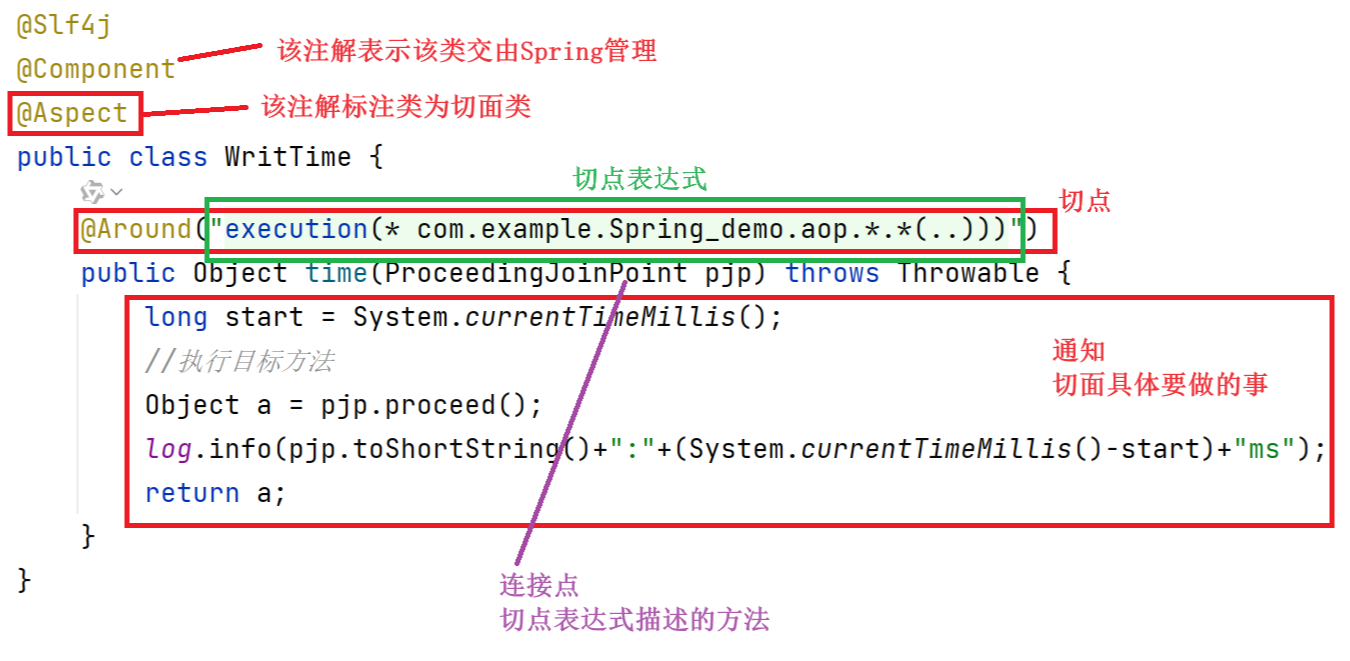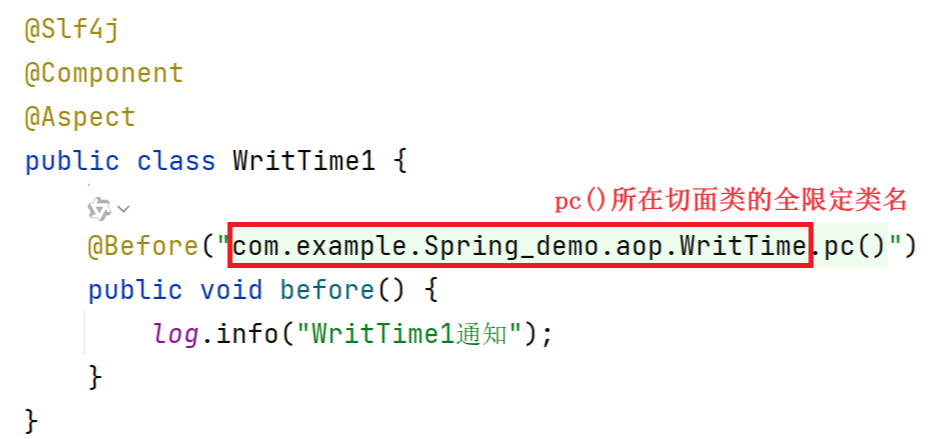- 大数据可视化算法推荐情感分析——基于Django电影评论数据可视化分析
- Spring AI与大模型Ollama如何集成整合?
- [架构之路-214]- UML-类图图解、详解、结构化、本质化讲解
- three.js 基础认识与简单应用
- 面试总结------20240404---项目
- GmSSL-3.1.1编译
- 前端文件上传(文件上传,分片上传,断点续传)
- 【python】flask各种版本的项目,终端命令运行方式的实现
- 【讯飞星火大模型AI】SpringBoot项目快速接入讯飞星火API
- 【Go设置国内代理】
- mysql中find
- 基于时域有限差分法的FDTD的计算电磁学算法-YEE网格下的更新公式推
- ELFK日志分析系统之搭建ELF+Filebeaat+Zookeepe
- Python+MySQL爬取船讯网AIS静态数据
- MySQL 中内连接、左连接、右连接有什么区别?
- 14.网络爬虫—数据提取2-正则表达式规则详讲
- Spingboot3详解(全网最详细,新建springboot项目并详
- [ vulhub漏洞复现篇 ] Apache Flink目录遍历(CV
- Python 操作 json 数据
- Docker进阶:容器与镜像的导入和导出
- nginx Rewrite
- mysql的IN查询优化
- MySQL--数据的增删改
- 【Node.js小知识】npm install出现:npm ERR!
- MySQL中的基础查询操作
- NL2SQL基础系列(1):业界顶尖排行榜、权威测评数据集及LLM大模
- Python某城市酒店爬虫数据可视化分析和推荐查询系统
- 30天拿下Rust之深入Cargo
- 【神经网络模型】——AI大模型学习
- 使用gradle创建spring项目时报错Could not reso
AOP是Spring框架的核心之一,AOP是一种思想,它的实现方法有很多,有Spring AOP,也有AspectJ、CGLIB等。我们熟知的拦截器其实就是AOP思想的一种实现方式。
AOP是一种思想,是对某一类事情的集中处理。
Spring AOP的实现方式:
- 基于注解 @Aspect;
- 基于自定义注解;
- 基于Spring API(通过xml配置的方式);
- 基于代理来实现。
想要实现Spring Aop需要先引入以下依赖。
org.springframework.boot spring-boot-starter-aop
例如:我们此时想要优化一个接口的执行效率
此时有一个接口如下:
@RequestMapping("/aop")
@RestController
public class Main {
@Autowired
private ForService fs;
@RequestMapping("/fun1")
public void fun1() {
fs.fun(3);
for (int i = 0; i < 1000; i++) {};
}
}
@Service
public class ForService {
public int fun(int i) {
for (int j = 0; j < 3000; j++) {
i++;
}
return i;
}
}
我们首先需要知道这个接口在执行过程中调用的各个方法的执行时间,然后再对每个方法进行针对性优化。用AOP思想来实现:
基于注解 @Aspect
@Slf4j
@Component
@Aspect
public class WritTime {
@Around("execution(* com.example.Spring_demo.aop.*.*(..)))")
public Object time(ProceedingJoinPoint pjp) throws Throwable {
//记录开始时间
long start = System.currentTimeMillis();
//执行目标方法
Object a = pjp.proceed();
//打印方法执行时间。pjp.toShortString()方法会返回方法签名的简写
log.info(pjp.toShortString()+":"+(System.currentTimeMillis()-start)+"ms");
return a;
}
}


切点:也称之为"切入点",提供⼀组规则(切点表达式)告诉程序对哪些方法来进行功能增强;
连接点:满足切点表达式规则的方法,就是连接点。也就是可以被AOP控制的方法;
通知:就是具体要做的工作,指哪些重复的逻辑,也就是共性功能(最终体现为⼀个方法);
切面:切点+通知。
切面类:切面所在的类,一个切面类中可以包含多个切面。
切点表达式:
常见的切点表达式有两种表达方式:
- execution(……):根据方法的签名来匹配
- @annotation(……):根据注解匹配

访问修饰限定符和异常可以被省略。
* :匹配任意字符,只匹配一个元素(返回类型,包,类名,方法或者方法参数)
- 包名使用 * 表示任意包(一层包使用一个*);
- 类名使用 * 表示任意类;
- 返回值使用 * 表示任意返回值类型;
- 方法名使用 * 表示任意方法;
- 参数使用 * 表示⼀个任意类型的参数。
.. :匹配多个连续的任意符号,可以通配任意层级的包,或任意类型,任意个数的参数
- 使用 .. 配置包名,标识此包以及此包下的所有子包;
- 可以使用 .. 配置参数,任意个任意类型的参数。
+:表示匹配当前类和其子类
通知类型:
- @Around:环绕通知,此注解标注的通知方法在目标方法前后都被执行;
- @Before:前置通知,此注解标注的通知方法在目标方法前被执行;
- @After:后置通知,此注解标注的通知方法在目标方法后被执行;
- @AfterReturning:返回后通知;
- @AfterThrowing:异常后通知。
多种通知类型的执行顺序
现有如下接口:
@Slf4j @RequestMapping("/aop") @RestController public class Main { @RequestMapping("/fun1") public void fun1() { log.info("执行fun1方法"); } }定义如下切面类,里面有多个切面。
@Slf4j @Component @Aspect public class WritTime { @Around("execution(* com.example.Spring_demo.aop.*.*(..)))") public Object time(ProceedingJoinPoint pjp) throws Throwable { log.info("@Around 方法前"); //执行目标方法 Object a = pjp.proceed(); log.info("@Around 方法后"); return a; } @Before("execution(* com.example.Spring_demo.aop.*.*(..)))") public void before() { log.info("@Before 前置通知"); } @After("execution(* com.example.Spring_demo.aop.*.*(..)))") public void After() { log.info("@After 后置通知"); } @AfterReturning("execution(* com.example.Spring_demo.aop.*.*(..)))") public void AfterReturning() { log.info("@AfterReturning 返回后通知"); } @AfterThrowing("execution(* com.example.Spring_demo.aop.*.*(..)))") public void AfterThrowing() { log.info("@AfterThrowing 异常后通知"); } }
如果发生异常:

异常是可以再切面中被捕获的,但需要通知类型为@Around

@Pointcut
@Pointcut注解可以把公共的切点表达式提取出来,需要用到时引用该切入点表达式即可。
@Slf4j @Component @Aspect public class WritTime { @Pointcut("execution(* com.example.Spring_demo.aop.*.*(..)))") public void pc(){} @Around("pc()") public Object time(ProceedingJoinPoint pjp) { log.info("@Around 方法前"); //执行目标方法 Object a = null; try { a = pjp.proceed(); } catch (Throwable e) { } log.info("@Around 方法后"); return a; } @Before("pc()") public void before() { log.info("@Before 前置通知"); } @After("pc()") public void After() { log.info("@After 后置通知"); } @AfterReturning("pc()") public void AfterReturning() { log.info("@AfterReturning 返回后通知"); } @AfterThrowing("pc()") public void AfterThrowing() { log.info("@AfterThrowing 异常后通知"); } }
声明的切面表达式也可以再其他切面类中使用但需要提前声明
@Slf4j @Component @Aspect public class WritTime1 { //()里引用的切面表达式前必须加上全限定类名 @Before("com.example.Spring_demo.aop.WritTime.pc()") public void before() { log.info("WritTime1通知"); } }
多个切面类的执行顺序
@Slf4j @RequestMapping("/aop") @RestController public class Main { @RequestMapping("/fun1") public void fun1() { log.info("执行fun1方法"); } }定义以下三个切面类,每个类里面只有一个切面:
//第一个 @Slf4j @Component @Aspect public class WritTime1 { @Before("execution(* com.example.Spring_demo.aop.*.*(..)))") public void before() { log.info("WritTime1通知"); } } //第二个 @Slf4j @Component @Aspect public class WritTime2 { @Before("execution(* com.example.Spring_demo.aop.*.*(..)))") public void before() { log.info("WritTime2通知"); } } //第三个 @Slf4j @Component @Aspect public class WritTime3 { @Before("execution(* com.example.Spring_demo.aop.*.*(..)))") public void before() { log.info("WritTime3通知"); } }
如果存在多个切面类执行顺序默认是按照类名进行排序。
@Order
当存在多个切面类时可以通过@Order注解来定义各个切面类的优先级。
对上述切面类进行细微修改加上注解
//第一个 @Slf4j @Component @Aspect @Order(3) public class WritTime1 { …… } //第二个 @Slf4j @Component @Aspect @Order(2) public class WritTime2 { …… } //第三个 @Slf4j @Component @Aspect @Order(1) public class WritTime3 { …… }
基于自定义注解
使用自定义注解来计算方法的执行时间。
声明一个自定义注解:
//表示该接口只能作用于方法 @Target({ElementType.METHOD}) //该接口的生命周期 @Retention(RetentionPolicy.RUNTIME) public @interface Time { }使用切面类实现该注解的功能:
@Slf4j @Component @Aspect public class WritTime { //@annotation里面的值为要实现的目标注解的全限定类名 @Around("@annotation(com.example.Spring_demo.aop.Time)") public Object time(ProceedingJoinPoint pjp) throws Throwable { //记录开始时间 long start = System.currentTimeMillis(); //执行目标方法 Object a = pjp.proceed(); //打印方法执行时间。pjp.toShortString()方法会返回方法签名的简写 log.info(pjp.toShortString()+":"+(System.currentTimeMillis()-start)+"ms(注解实现)"); return a; } }给待测方法添加注解
@Slf4j @RequestMapping("/aop") @RestController public class Main { @Autowired private ForService forService; @Time @RequestMapping("/fun1") public void fun1() { forService.fun(1); for (int i = 0; i < 10; i++) {} } }
给已有的注解进行功能的增强
还可以使用上面的方式给已有的注解进行功能的增强(给@RequestMapping注解添加可以打印接口执行时间的功能):
@Slf4j @Component @Aspect public class WritTime { //@annotation里面的值为@RequestMapping注解的全限定类名 @Around("@annotation(org.springframework.web.bind.annotation.RequestMapping)") public Object time(ProceedingJoinPoint pjp) throws Throwable { //记录开始时间 long start = System.currentTimeMillis(); //执行目标方法 Object a = pjp.proceed(); //打印方法执行时间。pjp.toShortString()方法会返回方法签名的简写 log.info(pjp.toShortString()+":"+(System.currentTimeMillis()-start)+"ms(注解实现)"); return a; } }
AOP的优势:
- 代码无侵入:不修改原始的业务方法,就可以对原始的业务方法进行了功能的增强或者是功能的改变;
- 减少了重复代码;
- 提高开发效率;
- 维护方便。
- 代码无侵入:不修改原始的业务方法,就可以对原始的业务方法进行了功能的增强或者是功能的改变;














